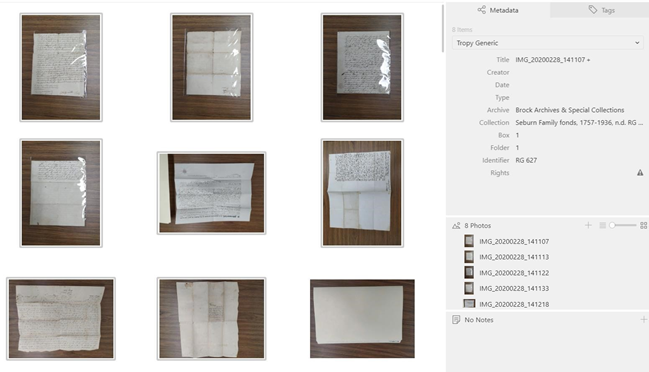
Research Photo Management with Tropy
Adapted by our colleague John Dingle from NCSU Libraries Digital Scholarship Workshop Series Available at: https://github.com/NCSU-Libraries/digital-scholarship-workshops
Setup: Download & Load Photos
- Download this repository as a zip file by clicking this link
- Unzip the file.
- Download Tropy at https://tropy.org
- Open Tropyfrom your Applications folder (Mac) or Programs folder (Windows). When you first start Tropy, you should see a window requesting you to Create a new project. In the future if you would like to create a new project, click File>New>Project.
- Add the nameof the collection you are working with for your research. For example, we will be working with the Seburn Family Collection, so enter “Seburn Family Research”
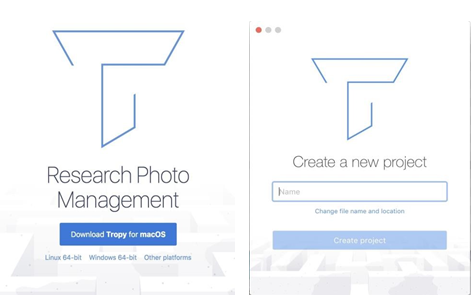
- Now you are ready to add photos to your project. Navigate to File> Importphotos. You can select one photo from your files, or Ctrl/Command+A, you can select multiple photos. Select all photos in theSeburn Family folder, then click open in the dialogue box.
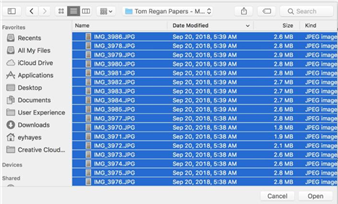
- Once you are in Tropy, if you need to find out where yourproject is saved,right-click on its name in the sidebar and select Show Project File.
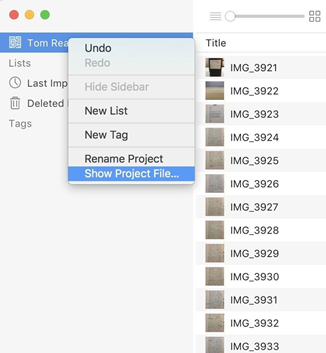
Grid & List View
You can view your items in a list or in a photo grid. To switch between these views, use the slider at the top of the item table. Your photos appear as a list when the slider is all the way to the left.
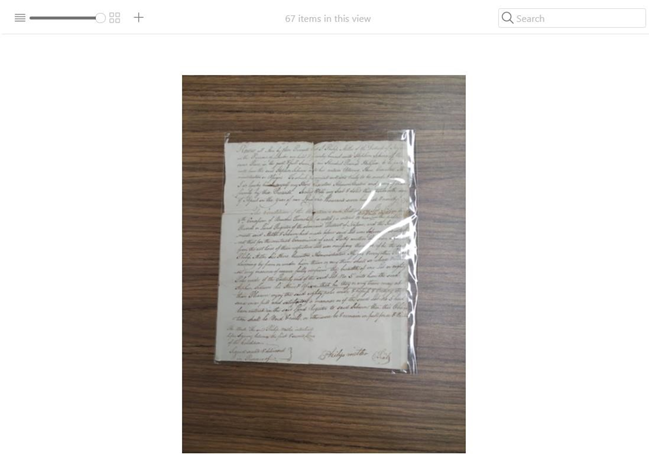
Editing Photos
Tropy allows you to do basic photo editing. You can do all your photo editing using the toolbar at the top of the photo pane in Item view.

From left to right, the buttons are as follows:
- Arrow: This is the basic tool for clicking on your photo. Double-clicking on your photo while the arrow is active will zoom your photo 100%.
- Select: This tool allows you to make selections that stand on their own.
- Rotate: This button rotates your photo counterclockwise by 90 degrees. The keyboard shortcut for this action is Ctrl+space.
- Mirror: This button flips your photo to its mirror.
- Pan: Pan allows you to move your photo around while it is zoomed in. You can also activate pan by holding down the space bar.
- Fit width: This button will fit your photo to the width of the window.
- Fill: This button will fill your whole photo into the window.
- Zoom slider: You can also manually zoom in or out on your photo.
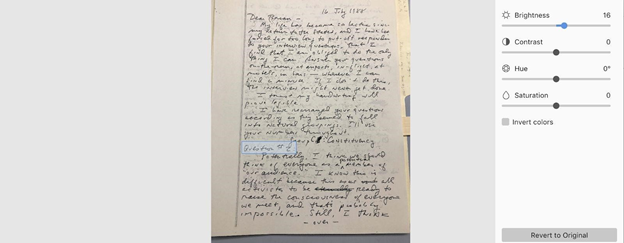
You can also adjust various settings on your photos to make them more legible. To access the advanced photo editing tools, click on the button on the far right of the photo editing panel.
Activity 1
Many of the images need to be rotated (eg. IMG_20200228_141218.jpg). Go through and rotate as many as you can in 2 minutes.
Adding Metadata
In Tropy, you can add Metadata for each item. Metadata can be as freeform as you want. But it’s generally best to try to record metadata using a standard that already exists. Why? Metadata standards provide consistency both within your own projects and also in the larger community of scholarship about your sources. Each category in a Tropy metadata template must be linked to a category (property) from an existing metadata standard. Tropy uses the Dublin Core metadata schema. If you would like to learn more about Dublin Core, visit http://dublincore.org/documents/dces/
At present you can only use each property once in a template. Several standards, or vocabularies, are included in Tropy. Tropy defaults to the “Tropy Generic” Metadata template, but you can select other metadata templates, such as the Tropy Correspondence template. The “Tropy Generic” Metadata template includes the following fields:
- Title: Name of the source or essential description of the item
- Creator: Author of the source
- Date: Date the source was created. In order to effectively organize and find sources based on date, use a consistent date format like YYYY-MM-DD (known as ISO format). If the date is uncertain, use ~ before the date (e.g., ~1802, or ~1802-01-01)
- Type: Type or genre of source. For example, Correspondence.
- Archive: is the location at which the source can be found, (e.g., the Library of Congress or Brock Archives and Special Collections).
- Collection: is the name of the collection of which the source is a part, (e.g. Seburn Family fonds). You should consult a catalog or finding aid to ensure that you use the correct title for a collection.
- Box: is the unit in the collection which the source can be found. This category may not be needed for all sources, as not all collections have boxes, so you may leave this field blank if not needed.
- Folder: is the folder (within a box) in which a source can found. This category may not be needed for all sources, as not all collections use folders as a form of organization, or label or number folders, so you may leave this field blank if not needed.
- Identifier: is a call number or URL at which a source can be found. This field could also be used to include a link to an online finding aid for a collection.
- Rights: is information about how you, a researcher, can use each item. This can include copyright information, as well as specific information from the archive where the image came from. Where possible, best practice is to include a link/URL to the information on rights provided by the archive or library where the source is located.
Editing Metadata in Bulk
- You can edit the metadata for multiple items at a time.
- Ctrl/Command+click on each item you want to edit; then type your metadata into the metadata pane on the right hand side. You may want to do this for the Archive, Creator, and Date fields.
- To select a large group, press Shift, then select the last item of the group you want to select. The metadata you input will be applied to all items you have selected.
- To select everything in the item table, press Ctrl/Command+A.
Activity 2
Press Shift and select the first 8 images. Add the following bulk metadata:
- Title:
- Creator:
- Date:
- Type:
- Archive: Brock Archives & Special Collections
- Collection: Seburn Family Fonds
- Box: 1
- Folder: 1
- Identifier: RG 627
- Rights: Current copyright applies
Editing Metadata for an individual item
To add or edit metadata to describe your item, click on it to select it. In the metadata pane on the right hand side of the project view, select a template from the pull-down menu. Then you have several options for adding information.
Activity 3
Select IMG_20200228_141752 and Tropy Generic Metadata on the right hand side of the project view then add the following Metadata fields:
- Title: Will of Jacob Seburn
- Creator: Seburn, Jacob
- Date: 1869-09-06
- Type: Will
- Archive: Brock Archives & Special Collections
- Collection: Seburn Family Fonds
- Box: 1
- Folder: 6
- Identifier: RG 627
- Rights: Current copyright applies
Adding Tags
In the tags tab of the metadata pane, click Add Tag to Item, and then start typing a tag, and you will see suggestions of existing tags to autocomplete.
Activity 4
Browse through the collection. Identify at least 3 tags that would potentially help you to find items in the collection in the future and add these to the relevant items
Creating a multi-image item
Hold down the Command/Ctrl key, then click on each image. Right-click, then click Merge selected items from the drop-down menu. Alternatively, drag and drop images on top of one another to create a multi-page document.
Activity 5
Merge these images into a single item:
- IMG_20200228_142110
- IMG_20200228_142138
- IMG_20200228_142157
- IMG_20200228_142219 Add appropriate metadata for the created item. Identify another set of images that should be merged into a single item and do so.
Lists & Annotations
To create a new list to organize collection items, right click your project and then select New List and enter a title. The new list appears in the sidebar. You can then drag and drop items to add them to the new list.
Activity 6
Create a list called “Wills”. Add images from IMG_20200228_141554 to IMG_20200228_142219 to the list. Identify another list that would be useful to create to help organize the content and do so
To create a selection, click on the dashed rectangle button on the photo editing toolbar. Then draw a rectangle on your photo that includes the area you wish to select. You can add annotations for the selected area.
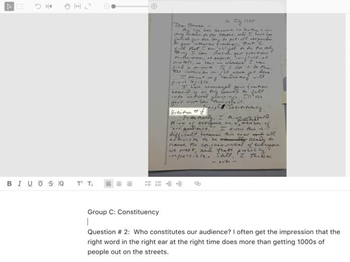
Searching for Items
In the search bar at the top right, you can search by tag, metadata, and notes. Try searching by some of the tags and metadata you have added to your items and review the results. You can also sort results by the metadata columns available in the project view and list views.
Activity 7
Add date metadata to all items in the ‘Wills’ list, then sort by date from earliest to latest.
Exporting items from Tropy
To export from Tropy, right-click on an item in the table. From the right-click menu, select Export Item > JSON-LD. This action will open a dialog box, where you can save your JSON file onto your computer. To export multiple items, Ctrl/Command+click or Shift+click to select multiple items. Then right-click and select Export Selected Items.
At present, Tropy only exports metadata to JSON-LD, not associated photos. Your photos still exist outside Tropy as well, since importing in Tropy copies your photos. JSON stands for JavaScript Object Notation. It is a very common interoperable syntax for exchanging data used for asynchronous browser–server communication. Use a text editor such as Text Wrangler, Notepad++, Atom or Brackets to open the JSON file.
Creating a new metadata template and adding properties
Navigate to Tropy > Preferences and click to the Templates section. When you first open the Preferences pane, a New Template will be the default, but if you click over to one of the other templates, you can get back to New Template by clicking on it in the Template drop-down box or by clicking the first button next to the drop-down. You must fill in the Name, Creator, Description and then click create. You can then add more metadata properties relevant to your items.
